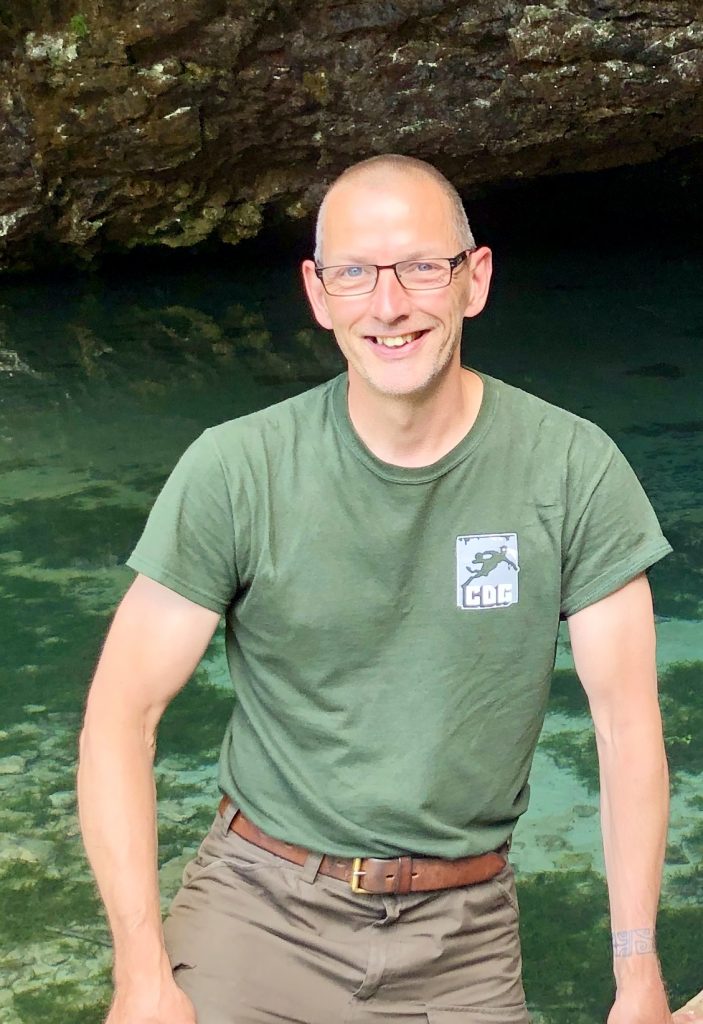Phil started diving in 1990 from a background of dry caving and climbing, by completing a PADI Open Water Diver course with Course Director Steve Axtell. He became a member of the British Cave Diving Group (CDG) and attained Qualified Diver status. In 1991 he qualified as a PADI Instructor and began teaching full time, working his way up to Master Instructor.
He began developing his Technical Diving skills through training with IANTD and in 1993 under the mentorship of Kevin Gurr and was involved in forming one of the first Trimix wreck diving teams in the UK.
He is now one of the world’s foremost IANTD Instructor Trainer Trainers in addition to being a member of the IANTD HQ Board of Advisors and was appointed the Training Director of IANTD UK by Tom Mount in 2011.
Phil retains active Instructor status with IANTD, NSS/CDS, TDI & PADI and is an Instructor Trainer for IANTD & TDI.
Cave diving, his true passion, has taken him on expeditions to Mallorca, France, Spain, Russia, Greece and Mexico.
He has been involved in film projects for ITV, BBC, Discovery, Nova and Channel 4 on the M1 submarine, the shipwrecks from the battle of Jutland and cave diving projects in Northern Spain ‘The Road to Certain Death’ and the UK ‘Secret Underground’, the BBC series ‘Oceans’, the Movie ‘Sanctum’, a Discovery ‘Curiosity’ series documentary on the J2 Cave Project and a documentary on the location and recovery of a WWII co-pilot from a downed B-24 Bomber off Vis Island in Croatia.
Phil’s professional diving activities include being DSO Diving Safety Officer on WHOI (Woods Hole Oceanographic Institute), USA National Parks Service Submerged Cultural Resources, Lund University Sweden and DPAA Defence POW/MIA Accounting Agency projects in Greece, Croatia and Sweden.
Phil completed a 3 month expedition with Bill Stone to the mountains of Southern Mexico where he spent 45 days underground in 3 exploratory trips of 19, 5 and 21 days caving and diving to extend the J2/Last Bash cave system to over 10 kilometres in length and 1,200 metres of depth passing sump 4 at 500 metres of length in 2013.
Phil has been diving professionally for 30 years and has logged over 6,000 dives in caves and open water using both open and closed circuit equipment, with over 4,000 dive hours on a rebreather and is currently the owner of Dark Water Exploration Ltd. and Diving Operations Manager for Lund University.
Phil is a Fellow of the Royal Geographical Society (FRGS) and a Fellow of the Explorers Club, holds the NSS-CDS Sheck Exley 1,000 safe cave dives award and was Diver of the Conference at Tek Dive USA 2016.
Why and how do you use checklists?
In diving, my use of checklists starting at my very beginnings when my Open Water Diver course instructor, Steve Axtell, introduced me to the pre-dive buddy check. I don’t think BWRAF (Buoyancy, Weights, Releases, Air Supply, Final OK) will ever leave my immediate memory. This simple acronym for the buddy check used and taught by PADI has stayed with me over 30 years of first recreational and technical sport diving and sport diver education with open and closed circuit equipment and now to this day with scientific, media and commercial diving projects as a team diver and a project DSO (Diving Safety Officer). Of course, the simple BWRAF has evolved, been added to, and been changed to suit environment, task and equipment but the underlying purpose to check via a checklist is still there and as if not more important than it ever was.
The second step in my checklist journey was my CCR training through IANTD by initially Dave Thompson who introduced me to my next pre-dive check acronym FLAGS (Flow, Loop, Analyse, Gas, Stack/Sensors).
The third phase of my use of checklists in diving came over a 15 plus year period where I worked as a trainer, educational system author/designer and test diver for a CCR and dive computer under the mentorship of industry legend Kevin Gurr. My first extensive exposure to rebreathers was during treasure recovery projects in the Gulf of Mexico and Guam and these rebreathers were MK 15.5 and used long extensive and detailed printed paper check sheets each day that were reviewed by the supervisor before loading the boat and then shorter ‘Pre-Jump’ checklists on kitting up prior to water entry.
From this the logical progression was to extend this process in a simple functional way to the Sport Diving Industries growing use of rebreathers for sport and technical diving. A method to encourage and simplify checks so that divers did do them and did not get lazy or complacent and skip them.
Over my career I have seen this goal approached from many angles including plastic or engraved metal credit card size pre-jump checklists attached to the rebreather, checklists on waterproof slates, in the manufacturer’s manuals or agency’s training manuals. All of these work… if used these all work, if used! Another method I have used and been involved in the design of is to have the checklists within the electronics of the CCR either as a simple set of prompts or integrated within the CCR’s functionality (e.g. to use digital H.P. gauges to monitor pressure and usage.
And remember, checklists are not just for rebreather divers but for all divers at all levels, beginner to explorer, instructor or instructor trainer and commercial diver and for all configurations and types of equipment be that open or closed circuit, back or side mounted. And don’t only check one part! A CCR Diver can complete a thorough and complete set of CCR checks and enter with no fins, weights or their dry suit unzipped!
Pre-event checks have been proven to work and to save lives in the aerospace communities for decades… They work for divers too.

